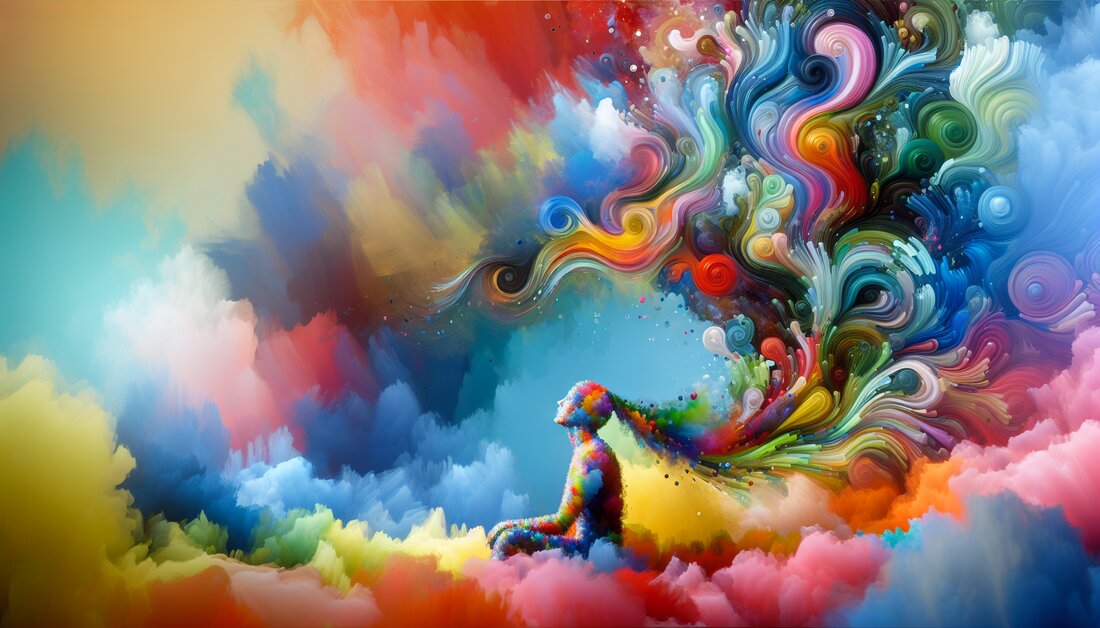Color therapy: healing through colors
Explores the science behind color therapy, from its emotional impact to practical application. Immerse yourself in the fascinating world of colors!

Color therapy: healing through colors
Color therapy is a fascinating bridge between science and the mysterious world of emotions that subtly permeate our daily lives. Despite its long tradition as a healing method, the question of how exactly colors can influence our health and well-being remains an exciting field of research. In our article, we delve deep into the scientific basis of color therapy to examine its effectiveness and the areas in which it is used. We explore the complex relationship between color psychology and emotional responses, showing how different hues can shape our mood and even our decisions. Finally, we offer practical instructions that take the reader from theory to implementation in everyday life. Get ready to discover the healing power of colors in a way that combines science and sensuality.
The scientific basis of color therapy: An examination of its effectiveness and areas of application
Color therapy, also known as chromotherapy, is based on the assumption that colors can influence physiological and psychological processes in the human body. This form of therapy uses the specific wavelengths of light emitted by colors to improve health and well-being. Scientific research on this topic is mixed, but offers some insights into possible mechanisms and areas of application.
- Physiologische Wirkungen: Farben beeinflussen die Produktion von Hormonen und können dadurch Stimmung und Emotionen regulieren. Beispielsweise kann Blaulicht die Produktion von Melatonin unterdrücken und so den Schlaf-Wach-Rhythmus beeinflussen, während rotes Licht die Melatoninproduktion weniger beeinflusst.
- Psychologische Wirkungen: Farben können auch direkte psychologische Effekte haben. So wird oft berichtet, dass Blau eine beruhigende Wirkung hat, während Rot als anregend und energetisierend empfunden wird.
- Anwendungsgebiete: Die Farbtherapie wird in verschiedenen Bereichen eingesetzt, unter anderem in der psychologischen Beratung, bei der Behandlung von saisonal abhängigen Depressionen, bei Schlafstörungen und zur Stressreduktion.
Scientific research on color therapy includes studies that indicate the effects of color on humans. For example, one study showed that blue light can improve cognitive performance and attention, which has been suggested for the treatment of ADHD.
| Color | Physiological effect | Possible application |
|---|---|---|
| Blue | Suppresses melatonin | Sleep disorders, depression |
| Red | Increases heart rate | Lack of energy, motivation |
| Green | Soothes, relaxes the eyes | Stress relief, relaxation |
Despite these research findings, color therapy remains a controversial field because a direct causal relationship between color and health benefits is often difficult to prove. Critics emphasize that many studies have methodological flaws and further high-quality research is needed to confirm specific effects and their applicability in practice.
Color psychology and emotional effects: How different colors influence our emotional world
Color psychology looks at how colors influence human behavior and emotions. Different hues can evoke different psychological reactions depending on individual experiences, cultural differences and context.
Redis often associated with energy, passion and danger. It can increase heart rate and increase feelings of excitement or intensity. In marketing, red is often used to attract attention and convey a sense of urgency.
Blue, on the other hand, has a calming effect and can promote trust. Shades of blue are believed to reduce the production of stress hormones and promote a feeling of calm. In office environments, using shades of blue can help promote concentration and reduce stress levels.
Greenoften represents nature, growth and harmony. Green is believed to increase well-being and promote relaxation. In therapeutic settings, green can be used to reduce anxiety.
| Color | association | Effect |
|---|---|---|
| Red | Energy, passion | Increases heart rate, conveys urgency |
| Blue | Reassurance, trust | Promotes concentration, reduces stress |
| Green | Nature, growth | Increases well-being, promotes relaxation |
Color psychology has applications in a variety of areas, from designing workplaces to increase productivity to marketing products through the strategic selection of colors designed to evoke specific customer responses. These scientific findings support the theory that the conscious use of colors in our everyday lives and work environments can have profound effects on our emotional and psychological well-being.
However, it should be noted that reactions to colors can be subjective and are heavily influenced by personal experiences and cultural backgrounds. Therefore, the application of color psychology should be flexible and individually tailored to achieve the desired effects.
Practical instructions for using color therapy: From theory to healing practice
The practical application of color therapy is based on the targeted use of colors to promote mental and physical health. Beginning with an analysis of the patient's individual condition and needs, a therapist selects specific colors for treatment. There are various methods to use color therapy, including light exposure, meditation with colors, and the use of colored objects or spaces.
- Lichtbestrahlung: Bei dieser Methode wird der Körper oder spezifische Bereiche desselben mit Licht in bestimmten Farben bestrahlt. Diese Technik ist besonders beliebt bei der Behandlung von saisonal abhängiger Depression (SAD), wobei oft helles, weißes Licht eingesetzt wird.
- Meditation mit Farben: Hierbei konzentrieren sich die Teilnehmer auf eine ausgewählte Farbe oder visualisieren diese, um bestimmte emotionale oder physische Zustände zu fördern. Diese Methode kann zur Reduktion von Stress, Angstzuständen und zur Förderung der Entspannung beitragen.
- Nutzung von farbigen Objekten oder Räumen: Die Gestaltung von Umgebungen mit spezifischen Farben kann die Stimmung und das Wohlbefinden der Personen in diesen Räumen beeinflussen. So können beispielsweise blaue oder grüne Farbtöne in einem Arbeitsbereich Beruhigung fördern und die Konzentration steigern.
The selection of colors is based on their predetermined psychological and physiological effects. Some common applications are:
| Color | Desired effect |
|---|---|
| Red | Increase energy and metabolism |
| Blue | Calming, lowers blood pressure |
| Green | Relaxing, promotes healing |
| Yellow | Stimulating, improves mood |
No specific prior knowledge is required to practice color therapy, but training in color theory and therapy as well as an understanding of the emotional and physiological effects of colors can be helpful. Professional color therapists also conduct an individual assessment of the patient's needs and condition to select the most appropriate colors and methods.
Scientific studies on the effectiveness of color therapy show mixed results and further research is needed to fully evaluate its effectiveness. Nevertheless, many people report positive experiences and improvements in their well-being through the use of color therapy. It is crucial to view color therapy as a complementary treatment that should support, but not replace, traditional medicine.
In conclusion, color therapy is a fascinating field at the intersection of science and alternative healing. The studies and theoretical considerations listed underline the potential that lies in the targeted use of colors for therapeutic purposes. As we have seen, the psychological impact of colors plays a crucial role, which can lead to significant emotional and physical reactions on both an individual and general level. The practical instructions offer an initial insight into how these insights can be used to promote well-being.
It is clear that further research is needed to fully understand and validate the effectiveness of color therapy. Nevertheless, the results so far provide a promising basis for further exploration in this area. It is noted that the integration of color therapy approaches into therapeutic practices should go hand in hand with a sound knowledge of the psychological and physiological basis of color effects. The bridge between traditional medicine and color therapy could therefore not only open up new healing paths, but also lead to a deeper understanding of the role that colors play in our lives and health.
Sources and further literature
References
- Birren, F. (1961). Color Psychology and Color Therapy: A Factual Study of the Influence of Color on Human Life. McGraw-Hill.
- Schneider, S. (2004). Farbpsychologie in Marketing und Produktdesign. GRIN Verlag.
- Tehrani, J. (2021). Die Wirkung von Farbtherapie auf Stress und Angstzustände: Eine systematische Übersicht. Journal für alternative und komplementäre Medizin.
Studies
- Whitfield, T. W. A., & Wiltshire, T. J. (1990). Color psychology: A critical review. Genetic, Social, and General Psychology Monographs, 116(4), 385-411.
- Jacob, K. J., & Suess, J. (2022). Die Rolle der Farbe in der psychologischen Umgebung. Umweltpsychologie.
- Azeemi, S. T. Y., & Raza, S. M. (2005). A Critical Analysis of Chromotherapy and Its Scientific Evolution. Evidence-Based Complementary and Alternative Medicine, 2(4), 481-488.
Further reading
- O’Connor, Z. (2011). Color Psychology and Color Therapy: Myth or Science?. Faber and Faber.
- Buckalew, L. W., & Buckalew, N. M. (1981). An investigation of drug expectancy as a function of capsule color and size and preparation form. Journal of Clinical Psychopharmacology, 1(5), 245-248.
- Küller, R. (1991). Farbe und Psyche: Perspektiven zu Farbe und Licht in der Arbeitswelt. Verlag TÜV Rheinland.

 Suche
Suche
 Mein Konto
Mein Konto
